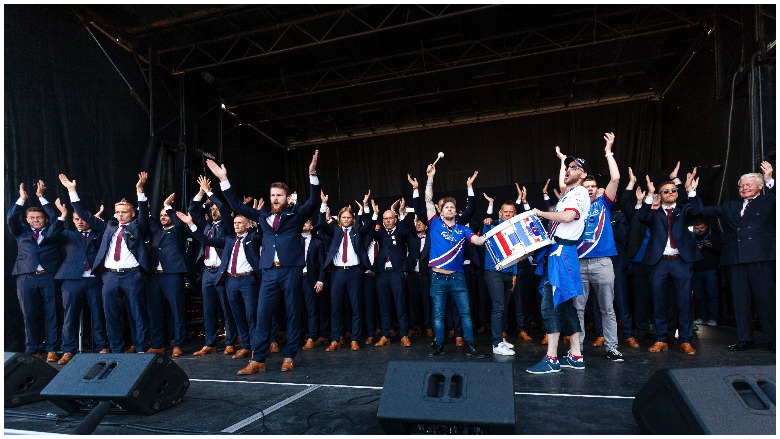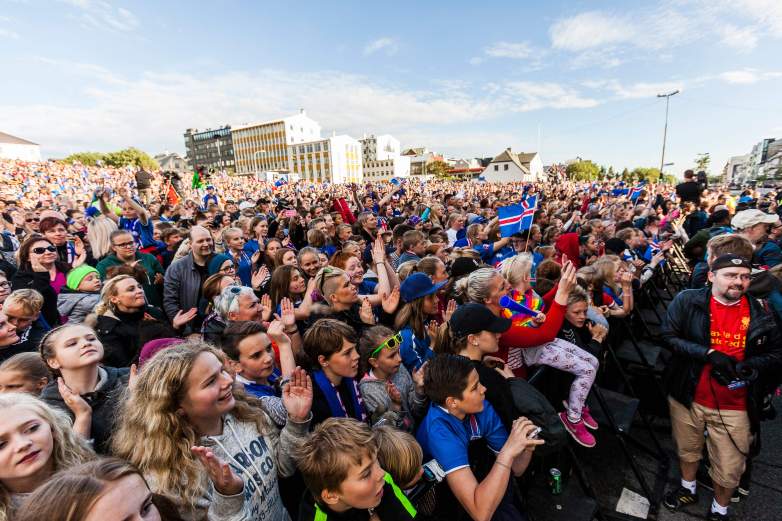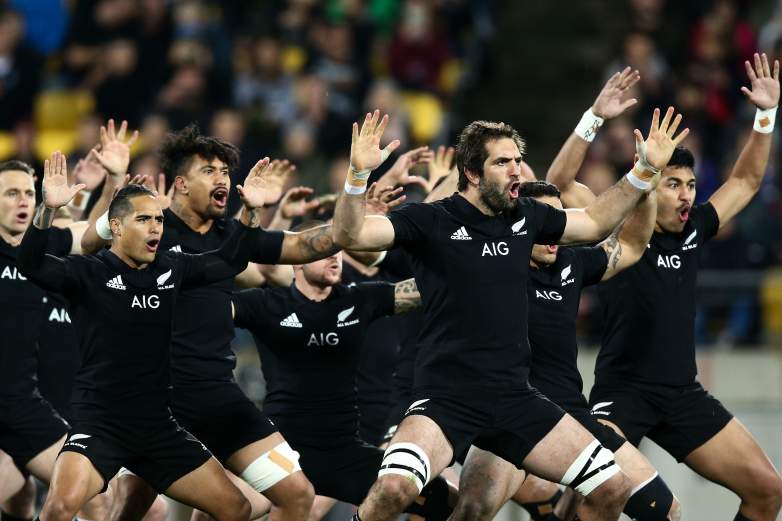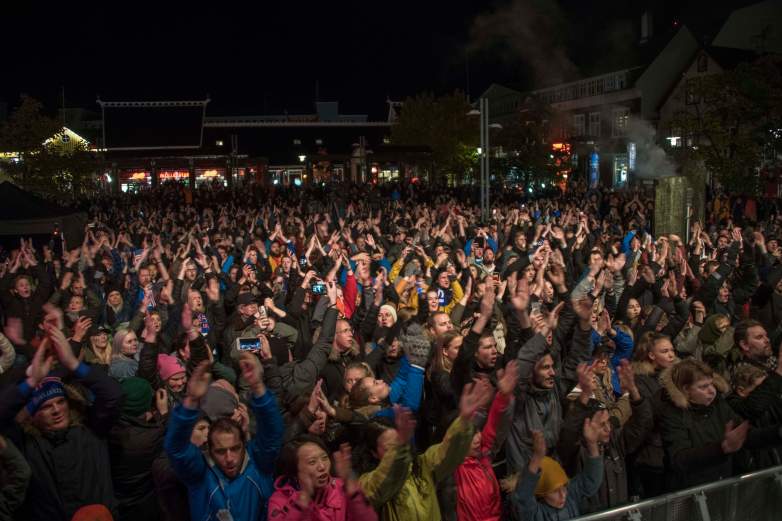
Iceland’s viking war clap became a legendary war cry, synonymous with Icelandic fans at the Euro 2016. The terrifying chant quickly became a world sensation, making its way over to the states, where the Minnesota Vikings made the war cry their own.
Watching tens of thousands of Icelandic soccer fans perform the chant is really a sight to be behold, with thousands of arms clapping in unison while fans shout a thunderous “HUH” to the sky.
The celebration has become a common practice for victorious teams at Euro 2016, but where did the song come from? Here’s what you need to know about Iceland’s Viking War Chant:
1. The Clap Became Famously Popular After Iceland Beat England in the 2016 European Championship

GettyPeople greet Iceland national football team upon its arrival in Reykjavik on July 4, 2016 and celebrate the players as winners after they lost against France during the the Euro 2016 quarter-final football match between France and Iceland on the day before. / AFP / Karl Petersson (Photo credit should read KARL PETERSSON/AFP/Getty Images)
Iceland’s intimidating slow chant, accompanied with a unanimous single clap, first drew attention following Iceland’s “last-gasp goal against Austria, which secured qualification for the last 16,” according to the Telegraph.
The claps and chants pick up speed before culminating in one final clap, accompanied by a cry of “HUH!” Check out the incredible video of 10,000 fans performing the chant below:
The incredible chant became famous during the European soccer finals in France in June, 2016. Players and fans of the Icelandic national team celebrated after beating England in the last 16 of the tournament, pulling off one of the greatest shocks in European Championship history.
The magazine Reykjavik Grapevine described the chant as: “And now we smite them into tiny pieces of dust and destroy their goal with a ball set on fire by our volcanic thunder.”
Iceland was the smallest country to ever compete in a major competition, making the match that much more historic.
2. The Chant Originated in Scotland During a Europa League Game Between Iceland’s Reykjavik & Scotland’s Motherwell

GettyThe Iceland national football team celebrates during a welcoming ceremony in Reykjavik on July 4, 2016 after they lost against France during the the Euro 2016 quarter-final football match between France and Iceland the day before. / AFP / Karl Petersson (Photo credit should read KARL PETERSSON/AFP/Getty Images)
Although Iceland’s adaptation of the chant garnered worldwide recognition after the Euros, according to Icelandic publication Morgunbladid, “the song was adopted by Icelandic club Stjarnan on a trip to Scottish side, Motherwell.”
The Telegraph reports that fans of the Reykjavik-based side were “first introduced to the terrifying terrace chant in a Europa League game with Scottish Premier League side, Motherwell. Motherwell’s slow-cap then evolves into the club’s trademark song, ‘Since I Was Young.'”
Despite eventually being knocked out of the Europe League by Inter Milan, fans of the Icelandic club introduced the clap to their national team, and adopted it after their victory over England in 2016.
Here’s the original video of the Scottish version:
3. The Minnesota Vikings Eventually Adopted the Chant & Made it Their Own, Replacing the Traditional “HUH” with a Thunderous “SKOL”
The war chant eventually made its way over to the United States, where the Minnesota Vikings NFL football team decided to adopt the song as its own. Vikings fans contacted the team about adopting the Icelandic chant following the viral video of the Icelandic national team and its supporters doing it together.
To get the chant going, the team enlisted Iceland soccer team captain Aron Gunnarsson and strongman and actor Hafþór “Thor” Björnsson, who plays “The Mountain” in the Game of Thrones, according to Iceland Magazine. The team opened up their first game at their new U.S. Bank Stadium in Minneapolis against the Green Bay Packers.
The Vikings did some minor changes to the chant to make it their own, by replacing the the traditional “HUH” with a bellowed “SKOL” instead (skál in Icelandic, meaning cheers or a toast). This is a reference to the lyrics of the fight song of the Vikings, “Skol, Vikings”, which has been with the team since around the time it was founded in 1961, according to Wikipedia.
You can watch Vikings fans chant their version of the war cry while General Jon Jensen of the Minnesota National Guard sounding the Gjallarhorn prior to the game below:
4. New Zealand’s Haka & Tonga’s Sipi Tau Are Both Popular War Chants Often Performed Before Rugby Games

GettyWELLINGTON, NEW ZEALAND – JUNE 16: Sam Whitelock of New Zealand leads the haka during the International Test match between the New Zealand All Blacks and France at Westpac Stadium on June 16, 2018 in Wellington, New Zealand. (Photo by Hagen Hopkins/Getty Images)
War cries and chants are historically popular, and are prevalent in sports around the world, most notably in rugby.
“These stem from traditional tribes and cultures in each respective country and have a real story behind them, with the Pacific Nations employing these dances and cries the most,” according to the Lad Bible.
The most famous of these are Tonga’s Sipi Tau and New Zealand’s infamous Haka. The Samoans also have their own cry, the Siva Tau, that the national Australian football team also uses.
The Haka originated as a traditional war cry of the Māori people, aboriginal descendants from New Zealand. It is a posture dance performed by a group, with vigorous movements and stamping of the feet with rhythmically shouted accompaniment, used as a tactic to intimidate enemies before battle.
The Sipi Tau, also known as the Kailko, serves a similar purpose in Tongan culture, as an expression of a war cry, dating back to the 1800’s when there were no challenges before war. It is unknown when Tongan rugby teams first adopted the war cry but it has becoming increasingly more popular for teams to perform before big games.
5. The Icelandic Chant Was So Popular that Other European Teams Started Adopting the Chant as Well

Iceland’s national team football players and coaching staff celebrate with fans at Ingolfstorg square in the centre of Reykjavik after the FIFA World Cup 2018 qualification football match against Kosovo in Reykjavik, Iceland on October 9, 2017.
Iceland qualified for the FIFA World Cup 2018 as smallest country ever after beating Kosovo 2-0 at home in Reykjavik. / AFP PHOTO / Halldor KOLBEINS (Photo credit should read HALLDOR KOLBEINS/AFP/Getty Images)
Other teams across Europe have adopted Iceland’s version of the war chant since the 2016 Euros. The Telegraph reports that Wales followed up their quarter-final win over Belgium with an impromptu version of the Icelandic celebration, and France also marked their semi-final victory over Germany with their own rendition.
Although Iceland adopted the chant from Scotland, there is some speculation that the war cry also has Polish roots, according to the Daily Mail. Others connect the song to the incredibly popular and visually breathtaking movie “300,” comparing the chant to the battle cry of the Spartan army in the the film.
Check out a few more videos of the Icelandic chant below: